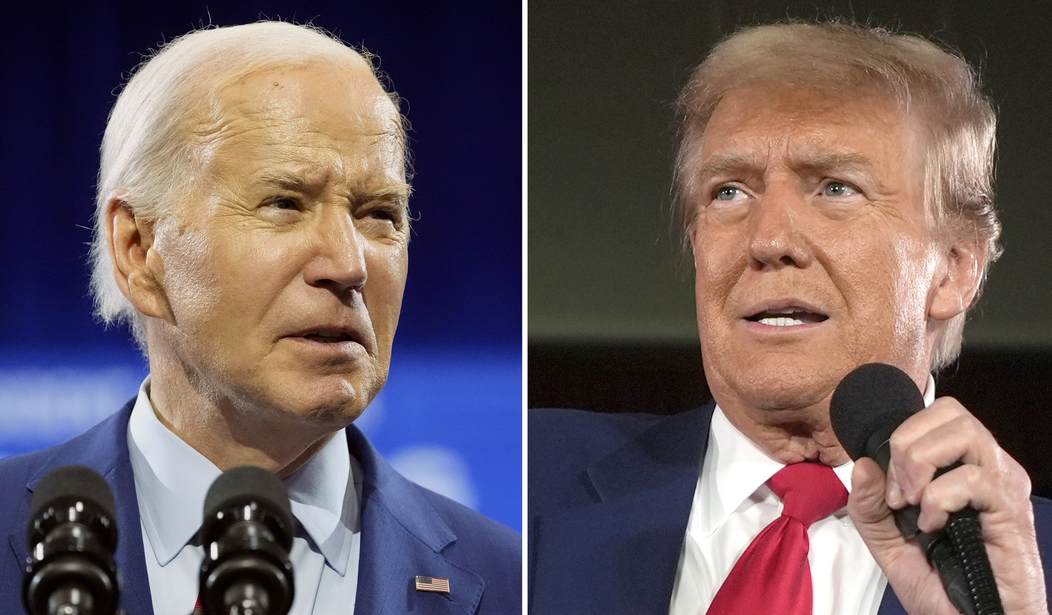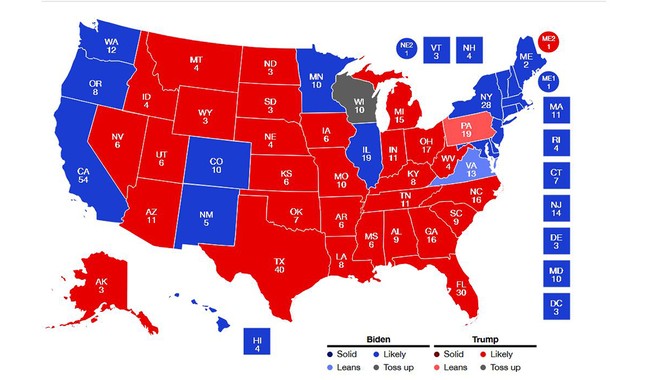The first presidential debate is Thursday; on this eve of that event, let's take a look at the current polling, the state of the likely Electoral College vote, and where things might go from here. It's been an interesting run so far, and it's likely to get more interesting still; the expectations-management of the Democrats has assured that President Biden will get a pass on his debate performance if he manages to stay conscious throughout the 90-minute performance, while former President Trump faces CNN moderators who will, candidly, be anything but impartial.
Individual polls, especially in an oddball race like this — an incumbent president facing a former president — are not particularly useful. Fortunately, the folks at RealClearPolling (RCP) have their aggregates, in which they combine the national polling to arrive at their moving average, and this is somewhat more useful as they average out biases and allow us to look at trends over time, so we can look at the battleground states, how the Electoral College is shaping up, and what might happen next.
First, the RCP averages of the battleground states. As of today, those states that are likely to decide the election are Arizona, Nevada, Wisconsin, Michigan, Pennsylvania, North Carolina, and Georgia. Trump leads in all of these save Wisconsin, where the average results in a tie, but many of them are narrow leads:
- Arizona: Trump +5.6
- Nevada: Trump +4.0
- Wisconsin: Tie
- Michigan: Trump +0.2
- Pennsylvania: Trump +2.8
- North Carolina: Trump +5.8
- Georgia: Trump +4.0
If former President Trump carries these states, that gives him a 312-226 victory over President Biden. If Trump loses Wisconsin, the one state that is at the moment, tied, he still ekes out a 302-236 win.
A wild card here is Virginia, and it's significant that the Old Dominion's governor, Glenn Youngkin, is reportedly among those being considered for Trump's VP pick. At present, Virginia is not listed in the RCP averages, but the most recent polls, conducted Jun 1-3 by Beacon Research, show a statistical tie. The last time the Old Dominion gave its Electoral College votes to a Republican was in 2004, in George W. Bush's reelection. It's not impossible that Virginia would break for Trump, although I'm rather skeptical about that; too many of the northern tier counties have become bedroom communities for the District of Columbia. But if that did happen, and all the other battlegrounds leaning right go for Trump, that gives the former President a decisive win, 325-213. Losing Wisconsin and gaining Virginia still has a 315-223 win.
It's still quite a way to Election Day, and a lot can happen. Former President Trump still faces his lawfare challenges, and there's just too much happening that is without precedent; we are quite literally entering an undiscovered country in this election cycle. But to what extent the past may inform the present, things aren't looking too bad for Team Trump.
See Related: Barack Obama Has Anxiety Over Biden Reelection, Holds Meetings With Joe on How to Win
Vivek Ramaswamy Still in VP Contention, Confirms He Will Be in Atlanta For the Debate
Now, my personal guesses as of this moment, as of this writing on the morning of June 26th, the day before Debate One.
The swing states have been leaning to the right and appear to be slowly gaining ground. Using the RCP interactive map, leaving Wisconsin as a toss-up, and relying on the polling for the other battleground states, this is where we are:
This resulted in a 302-226 win for former President Trump in his effort to channel his inner Grover Cleveland. Pennsylvania may well slip; the Philadelphia area reliably votes Democrat, but the increasing chaos in that city may turn some votes. Still, in this scenario, Trump can lose Pennsylvania and still squeak out a win, 283-245. If Wisconsin goes for Biden, Trump still wins, 283-255.
Nationwide head-to-head polls matter little at this point, except to judge extremely broad trends across the nation. I've always disliked the nattering about the "national popular vote." There is no such thing — I tell you three times, there is no national popular vote. It's just a statistical curiosity. This is not how we elect presidents, which is why all analyses like I've done here involve the Electoral College. But, as far as that statistical curiosity goes, in the RCP average, Trump is leading, 46.2 percent to 45.2 percent; in a five-way race with Robert F. Kennedy Jr., Cornel West, and Jill Stein, Trump pulls farther ahead, gaining 42.6 percent of the vote to Biden's 40.4 percent, Kennedy's 6.7 percent, West's 1.4 percent, and Stein's 1.1 percent. The one thing that makes the five-way comparison interesting is that it illustrates that the various third-party candidates are, as of now, hurting Biden more than Trump, and in some of these narrowly led battleground states, that may make a difference — think Florida, Ralph Nader, 2000.
In summary: If I were working for the Trump campaign, I'd be mildly optimistic right now. But it's a long way to Tipperary, folks. Stay tuned, and as things happen, I'll be updating my guesses.
















